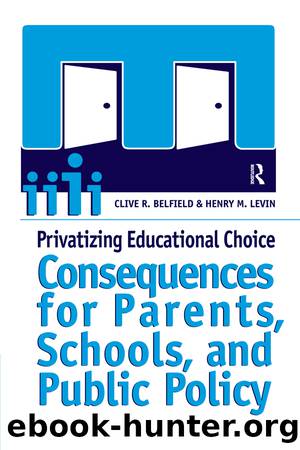Privatizing Educational Choice by Belfield Clive R.;Levin Henry M.;

Author:Belfield, Clive R.;Levin, Henry M.;
Language: eng
Format: epub
ISBN: 4186382
Publisher: Taylor & Francis Group
The Impact of Home-Schooling on U.S. Education
Designing Policies for Home-Schooling
Even if the rate of growth of home-schooling slows, the current size of the sector means that education policies need to address the demands of home-schoolers. To design policies for home-schooling, three interlinked instruments need to be considered: regulations, finance, and support services for students.
School regulations relate to durations of attendance in a school, teacher qualifications, curriculum content, reporting/approval, and testing/assessment. From a national review, statesâ requirements on home-schoolers are often summarized in a relatively short document. The main regulation is that home-schoolers notify the state with a Declaration of Intent (these are often downloaded from state Web sites). Durations of schooling are intended to be equal to a school year (with monthly attendance records to be submitted by the parent), and the curriculum is also expected to correspond to that of public schools (at least in terms of core courses). Parents (or tutors) may be expected to have at least a GED (or college degree, but not necessarily in the subject of instruction). At present, regulations on home-schooling appear very open: almost no instructional mode appears to be proscribed.
However, by law, a state has considerable latitude in regulating private schooling, and in some cases this may extend to home-schooling. Lerner (1995: 373) concludes that such regulation will be defensible when it focuses on educational outcomes (where the state can claim a strong interest). For home-schooling, this means thatâeven without committing fundsâstates can impose reporting requirements and mandate test assessments; they might also perform on-site inspections. But home-schoolers may more easily challenge regulations relating to inputs, such as attendance durations, curriculum content, teacher qualifications, and peer inputs.7
In conjunction with regulations, states and districts must also stipulate financing terms for home-schooling. Although funds for home-schooling are limited, home-based students do draw on resources from public schools by âopting inâ to particular school programs. This raises policy questions as to what resources these students are entitled to and to what extent they should be allowed to negotiate terms with the public school (citing administrative inconvenience, some states may refuse access to public school resources; see Fuller, 1998). If home-schooling conveys positive externalities, then direct funding may be justifiable (e.g., through education tax credits or vouchers). In some states, home-schools can be classified as part of the public school system (thus entitling students to funds, e.g., for those with disabilities; see Lambert, 2001). However, the appropriate amount of funding may be difficult to estimate (absent reliable data on home-schooling costs) and with funding will also come pressure for more regulation.
Finally, states must set out what support services are appropriate for home-schoolers. Typically, because such services include transportation and information on available school choices, the demands of home-schoolers in this respect may be small. (But home-based education does involve transportation to school.) Rather, home-schoolers may need support in accessing health services and educational counselling, as well as in identifying the resources available to them through the public system. Also, education officials must adopt policies for validating courses taken by home-schoolers who wish to enter the public school system.
Download
This site does not store any files on its server. We only index and link to content provided by other sites. Please contact the content providers to delete copyright contents if any and email us, we'll remove relevant links or contents immediately.
Cecilia; Or, Memoirs of an Heiress — Volume 1 by Fanny Burney(32061)
Cecilia; Or, Memoirs of an Heiress — Volume 3 by Fanny Burney(31457)
Cecilia; Or, Memoirs of an Heiress — Volume 2 by Fanny Burney(31408)
The Great Music City by Andrea Baker(30780)
We're Going to Need More Wine by Gabrielle Union(18632)
All the Missing Girls by Megan Miranda(14732)
Pimp by Iceberg Slim(13779)
Bombshells: Glamour Girls of a Lifetime by Sullivan Steve(13684)
Fifty Shades Freed by E L James(12915)
Talking to Strangers by Malcolm Gladwell(12873)
Norse Mythology by Gaiman Neil(12827)
For the Love of Europe by Rick Steves(11468)
Crazy Rich Asians by Kevin Kwan(8887)
Mindhunter: Inside the FBI's Elite Serial Crime Unit by John E. Douglas & Mark Olshaker(8700)
The Lost Art of Listening by Michael P. Nichols(7159)
Enlightenment Now: The Case for Reason, Science, Humanism, and Progress by Steven Pinker(6872)
The Four Agreements by Don Miguel Ruiz(6318)
Bad Blood by John Carreyrou(6277)
Weapons of Math Destruction by Cathy O'Neil(5830)
